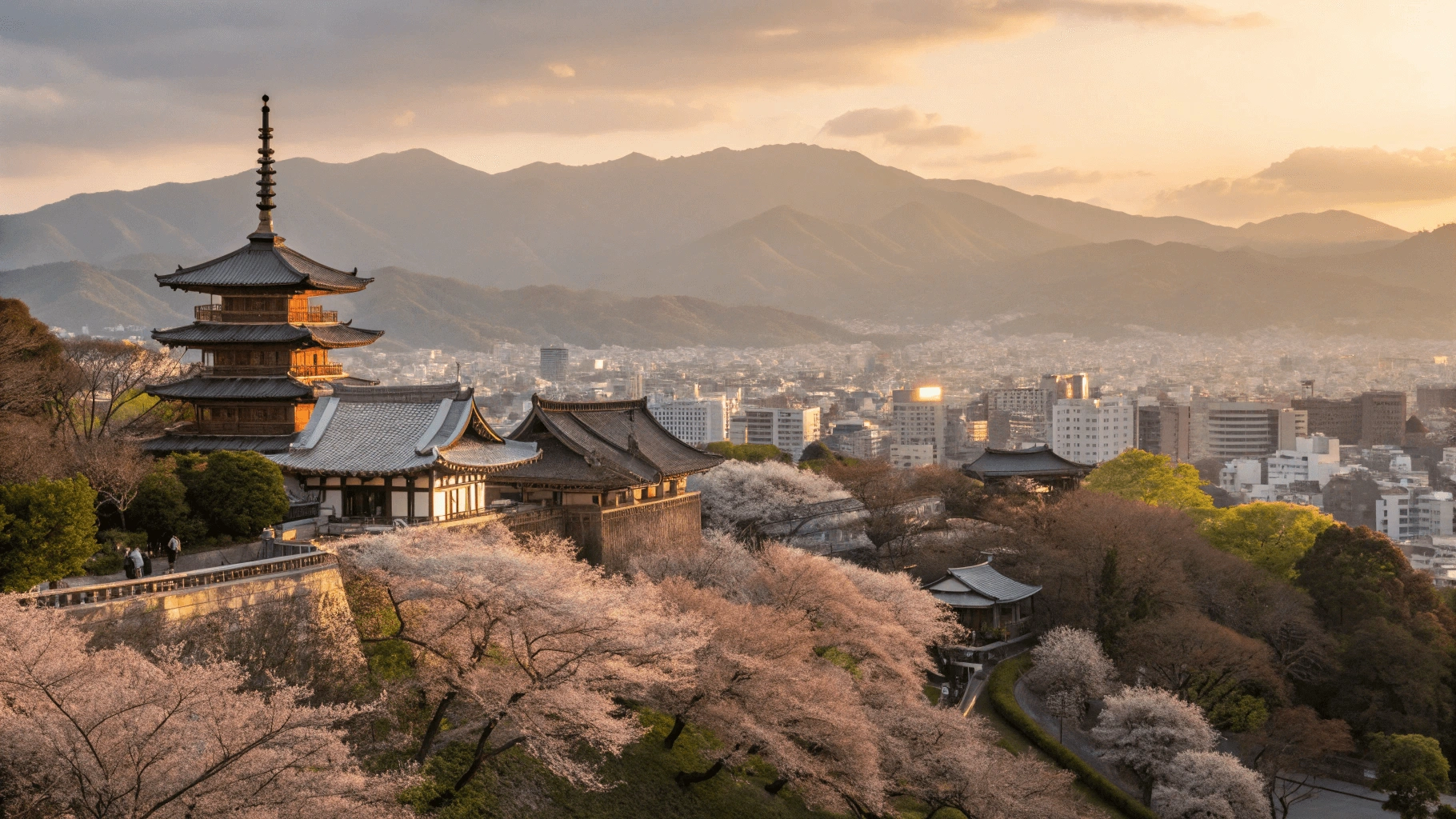Introduction: Discovering the Heart of Japanese Heritage
Welcome to Kinki Japan, the cultural and historical nucleus of the Japanese archipelago. Often referred to as the Kansai region, this vibrant area represents the beating heart of traditional Japan while simultaneously embracing modernity with characteristic enthusiasm. Home to ancient capitals, spiritual landmarks, culinary innovations, and natural wonders, Kinki offers travelers an unparalleled glimpse into the soul of Japan.
Nestled in the central-southern portion of Japan’s main island of Honshu, the Kinki region encompasses seven distinct prefectures, each with its own unique charm and attractions. From the bustling streets of Osaka to the tranquil temple gardens of Kyoto, from the sacred deer of Nara to the dramatic coastlines of Wakayama – this region encapsulates the essence of Japanese culture and history within a relatively compact geographical area.
This comprehensive guide will take you through everything you need to know about Kinki Japan, providing essential insights for planning an unforgettable journey through this remarkable region. Whether you’re a first-time visitor to Japan or a seasoned traveler looking to explore beyond Tokyo, Kinki offers endless discoveries that will transform your understanding of Japanese civilization and leave you eager to return.
Table of Contents
Kinki vs. Kansai: Unraveling the Naming Confusion
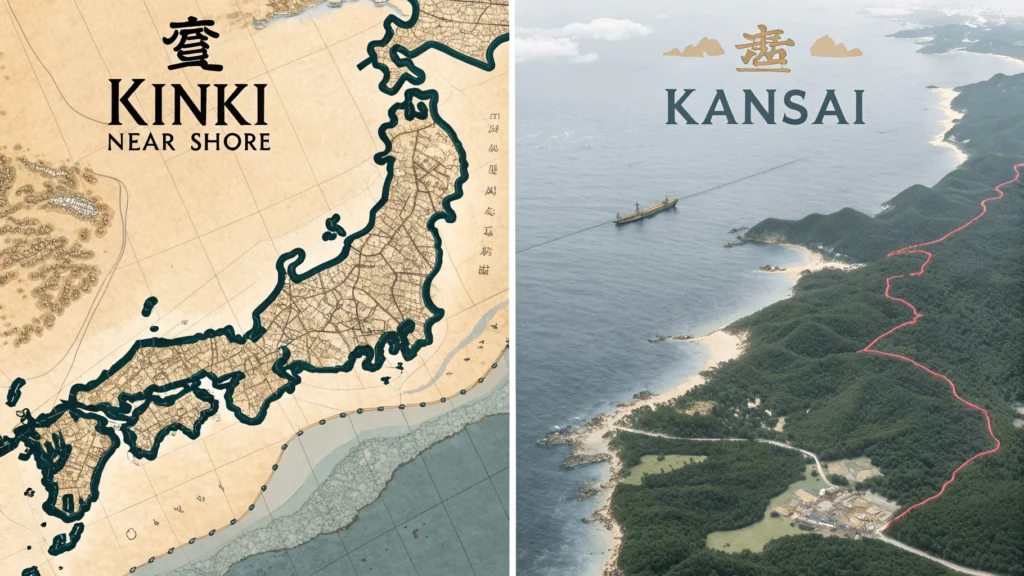
One of the first things visitors notice is the interchangeable use of “Kinki” and “Kansai” when referring to this region. This dual naming can be confusing, so let’s clarify the distinction:
Kinki (近畿) is the official geographic and administrative name for the region. The term literally means “near the capital” or “vicinity of the capital,” reflecting its historical significance as the area surrounding the ancient capitals of Nara and Kyoto. Government documents, maps, and official designations typically use “Kinki.”
Kansai (関西) translates to “west of the barrier” or “west of the checkpoint,” referring to its position west of the historical Hakone checkpoint that separated eastern and western Japan. This term emerged during the Edo period (1603-1868) when Tokyo (then called Edo) became the capital, and the regions were divided into Kansai (west) and Kanto (east).
Historical Context
The naming distinction has deep historical roots. For over a millennium, from 710 to 1868, the imperial capital was located within what is now the Kinki region (first Nara, then Kyoto). Even after the capital moved to Tokyo, the cultural influence of this region remained immense.
While government agencies and formal documents use “Kinki,” locals and everyday conversation favor “Kansai.” The regional dialect is called “Kansai-ben,” the airport is “Kansai International Airport,” and the power company is “Kansai Electric Power.”
This table highlights the key differences:
| Aspect | Kinki | Kansai |
|---|---|---|
| Type of Term | Official geographic designation | Cultural and colloquial term |
| Literal Meaning | “Near the capital” | “West of the barrier” |
| Historical Origin | Ancient period, referencing proximity to imperial capitals | Edo period, defined in relation to Tokyo |
| Common Usage | Government documents, administrative purposes | Daily conversation, regional identity, businesses |
| Geographical Scope | Precisely defined (7 prefectures) | Sometimes includes additional areas |
For travelers, understanding this distinction helps navigate both official materials and local conversations. Throughout this guide, we’ll primarily use “Kinki” for consistency with official designations, while acknowledging that many locals and businesses will refer to the region as “Kansai.”
Interactive Map of Kinki Region
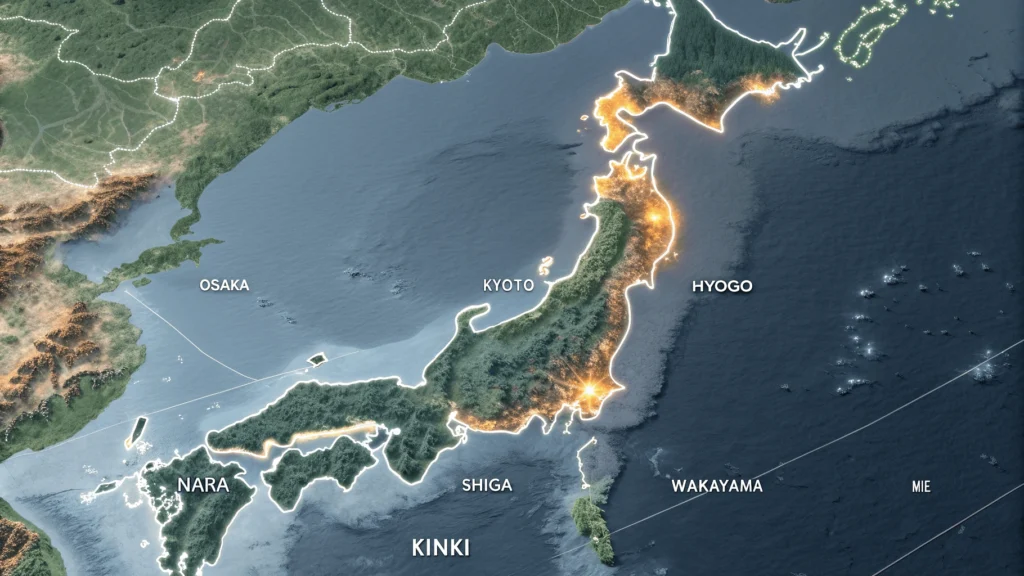
[Note: This section would feature an embedded Google Map highlighting the Kinki region’s prefectures, major cities, transportation hubs, and attractions]
The Kinki region spans approximately 33,000 square kilometers in central-western Honshu, bordered by the Sea of Japan to the north, the Pacific Ocean to the south, and the Inland Sea to the west. The region consists of seven prefectures:
- Osaka Prefecture – The economic powerhouse
- Kyoto Prefecture – The cultural capital
- Hyogo Prefecture – Home to the port city of Kobe
- Nara Prefecture – Japan’s first permanent capital
- Shiga Prefecture – Featuring Lake Biwa, Japan’s largest lake
- Wakayama Prefecture – Known for sacred mountains and coastlines
- Mie Prefecture – Famous for Ise Grand Shrine and ninja culture
This central location made the region ideal for Japan’s ancient capitals and continues to make it an accessible hub for modern travelers.
Prefecture Breakdowns: Exploring Kinki’s Diverse Regions
Osaka Prefecture: The Nation’s Kitchen
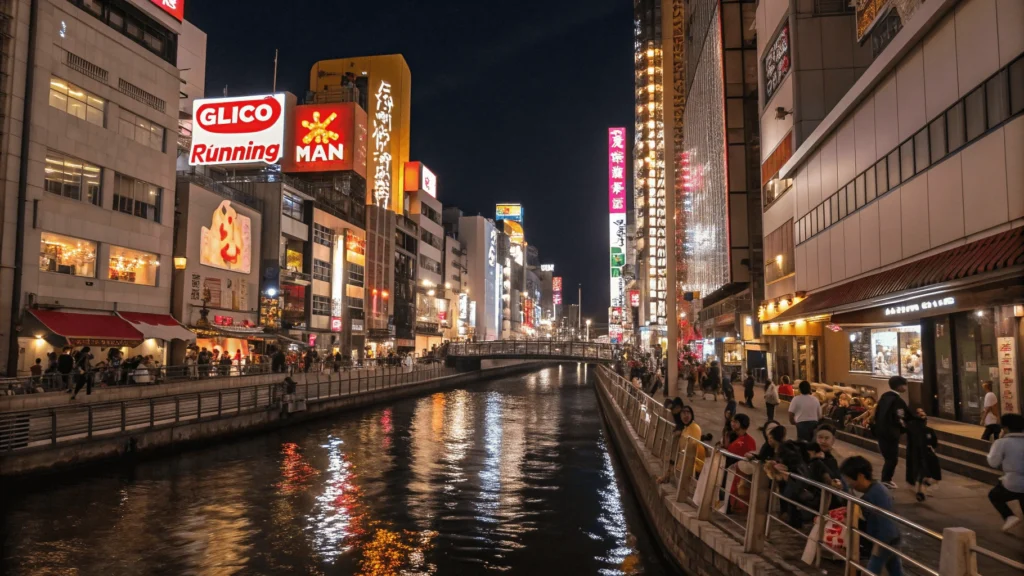
Key Characteristics: Dynamic urban energy, commercial center, food paradise, outgoing culture Major Cities: Osaka City, Sakai, Takatsuki Population: Approximately 8.8 million
Osaka Prefecture serves as the economic engine of the Kinki region and embodies the area’s famous humor, pragmatism, and culinary obsession. Often called “Tenka no Daidokoro” (the Nation’s Kitchen), Osaka developed as a merchant city where the philosophy of “kuidaore” (eat until you drop) still prevails.
Must-See Highlights:
- Osaka Castle and Park
- Dotonbori entertainment district
- Shinsaibashi shopping area
- Kuromon Ichiba Market
- Universal Studios Japan
- Sumiyoshi Taisha Shrine
The prefecture balances its modern urban landscape with historical sites like Osaka Castle, while maintaining a distinctly different atmosphere from Tokyo – more direct, comedic, and food-focused.
Kyoto Prefecture: The Cultural Capital

Key Characteristics: Traditional culture, refined arts, imperial legacy, temple architecture Major Cities: Kyoto City, Uji, Kameoka Population: Approximately 2.6 million
As Japan’s imperial capital for over 1,000 years (794-1868), Kyoto Prefecture represents the cultural and spiritual heart of the nation. With over 1,600 Buddhist temples, 400 Shinto shrines, and 17 UNESCO World Heritage sites, Kyoto offers unparalleled cultural riches.
Must-See Highlights:
- Kinkaku-ji (Golden Pavilion)
- Fushimi Inari Shrine with thousands of torii gates
- Arashiyama Bamboo Grove
- Kiyomizu-dera Temple
- Gion geisha district
- Byodo-in Temple in Uji (featured on the 10-yen coin)
Beyond the city itself, Kyoto Prefecture encompasses rural areas of outstanding natural beauty, from the tea fields of Uji to the sacred mountains of northern Kyoto.
Hyogo Prefecture: Diverse Landscapes
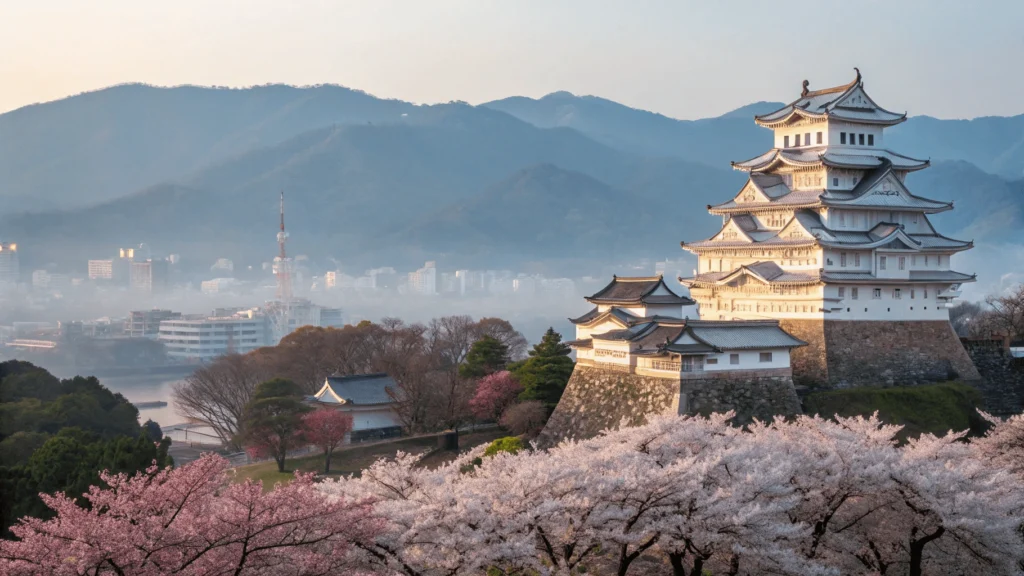
Key Characteristics: Port history, international influence, varied geography, hot springs Major Cities: Kobe, Himeji, Nishinomiya Population: Approximately 5.5 million
Hyogo Prefecture stretches from the Sea of Japan to the Inland Sea, encompassing diverse landscapes and cultures. The cosmopolitan port city of Kobe serves as the prefectural capital, offering a unique blend of international influences alongside traditional Japanese culture.
Must-See Highlights:
- Himeji Castle (Japan’s finest surviving feudal castle)
- Kobe Harborland and Port Tower
- Arima Onsen (one of Japan’s oldest hot springs)
- Kinosaki Onsen town
- Kobe Beef restaurants
- Akashi Kaikyo Bridge (world’s longest suspension bridge)
The prefecture’s diversity allows visitors to experience everything from elegant port city life to traditional onsen (hot spring) culture and pristine nature reserves.
Nara Prefecture: Ancient Heritage
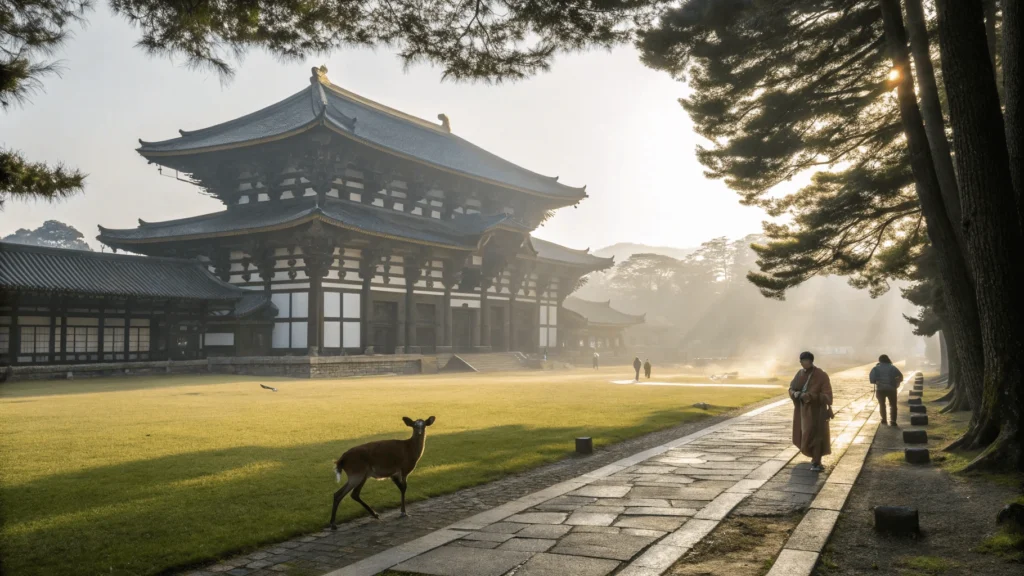
Key Characteristics: Ancient capital, Buddhist heritage, sacred deer, rural landscapes Major Cities: Nara City, Kashihara, Sakurai Population: Approximately 1.3 million
As Japan’s first permanent capital (710-784), Nara Prefecture houses some of the country’s oldest and most significant historical treasures. The prefecture’s cultural landscape is dominated by ancient temples, primeval forests, and the famous sacred deer that roam freely through Nara Park.
Must-See Highlights:
- Todai-ji Temple with the Great Buddha (Daibutsu)
- Nara Park and its sacred deer
- Kasuga Taisha Shrine with its stone lanterns
- Horyuji Temple (world’s oldest wooden structures), Horyu-ji is recognized by UNESCO as a World Heritage Site for its historic wooden architecture dating back to the 7th century.
- Yoshino mountain (cherry blossom paradise)
- Asuka historical area (birthplace of Japanese civilization)
Nara offers a more relaxed pace than its urban neighbors, with opportunities to explore Japan’s foundational historical sites in a serene setting.
Shiga Prefecture: Lake Kingdom
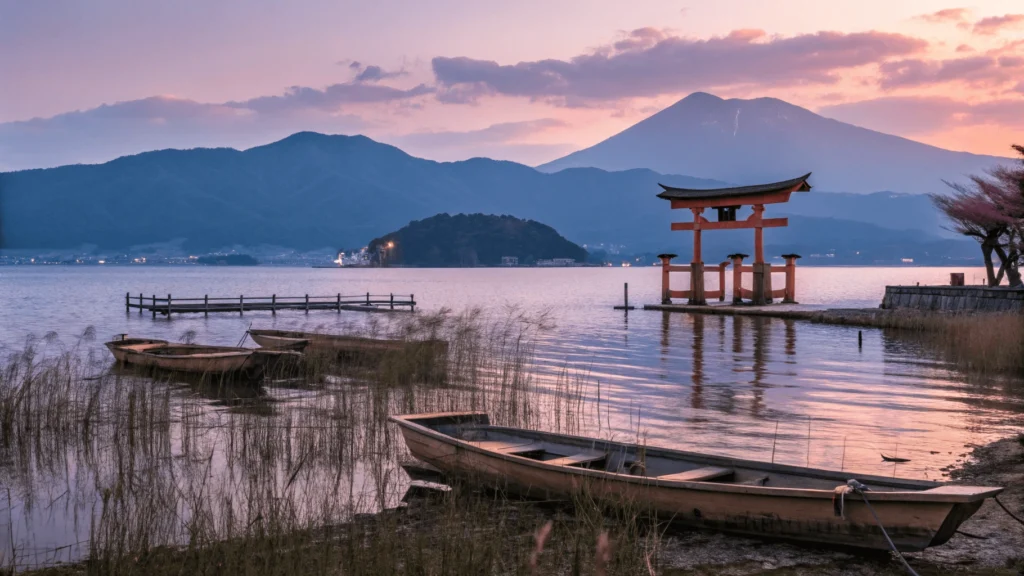
Key Characteristics: Lake Biwa ecosystem, castle towns, rural beauty, water resources Major Cities: Otsu, Hikone, Nagahama Population: Approximately 1.4 million
Dominated by Lake Biwa, Japan’s largest freshwater lake, Shiga Prefecture offers natural beauty, historical castle towns, and spiritual retreats. The prefecture has been a critical transportation junction throughout Japanese history, connecting eastern and western Japan.
Must-See Highlights:
- Lake Biwa and its surrounding recreational areas
- Hikone Castle (national treasure)
- Enryaku-ji Temple on Mount Hiei
- Omihachiman historic canal town
- Shirahige Shrine with its “floating” torii gate
- Metasequoia Avenue in Makino
The lake’s ecosystem has shaped local cuisine, culture, and spiritual practices, making Shiga a unique water-centered destination within the Kinki region.
Wakayama Prefecture: Spiritual Coastlines
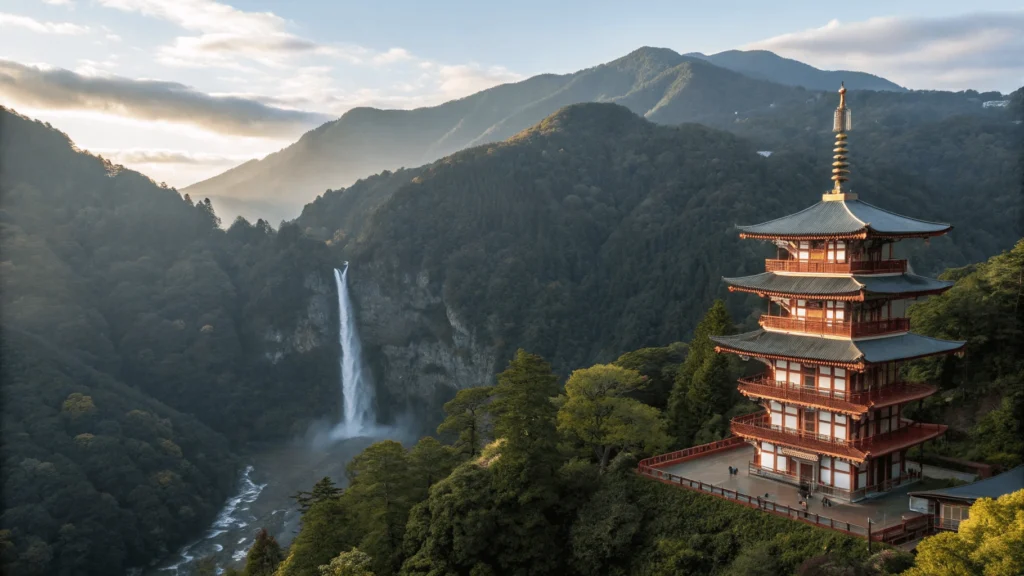
Key Characteristics: Spiritual pilgrimages, dramatic coastlines, hot springs, citrus cultivation Major Cities: Wakayama City, Tanabe, Shingu Population: Approximately 925,000
Located on the Kii Peninsula, Wakayama Prefecture combines spiritual significance with natural beauty. The prefecture is home to the sacred Kumano Kodo pilgrimage routes (UNESCO World Heritage) and has been a center for Japanese Buddhism and Shinto practices for centuries.
Must-See Highlights:
- Kumano Kodo pilgrimage trails, The Kumano Kodo is a designated UNESCO World Heritage pilgrimage route, reflecting its spiritual and cultural importance in Japanese history.
- Koyasan sacred mountain complex
- Nachi Falls and Kumano Nachi Taisha Shrine
- Shirahama Beach and onsen
- Wakayama Castle
- Adventure sports in the Kitayama River area
The peninsula’s remote setting has preserved traditional ways of life while allowing for immersive natural experiences rarely found in more developed parts of Japan.
Mie Prefecture: Coastal Treasures
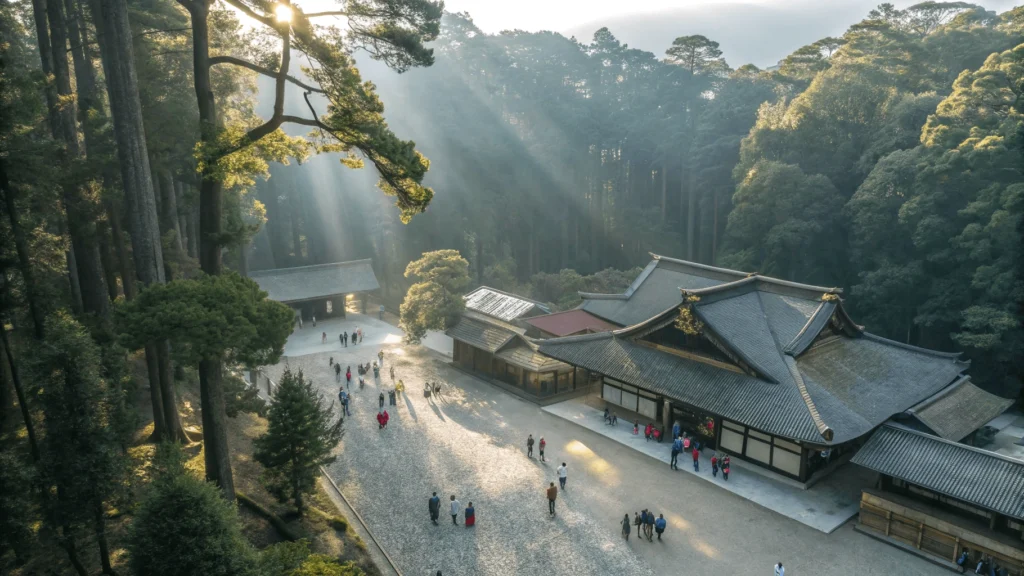
Key Characteristics: Ise Shrine, pearl cultivation, ninja tradition, seafood Major Cities: Tsu, Ise, Yokkaichi Population: Approximately 1.8 million
Stretching along the eastern coast of the Kii Peninsula, Mie Prefecture balances industrial development with deeply traditional areas. The prefecture houses Japan’s most sacred Shinto site, Ise Jingu, which is rebuilt every 20 years according to ancient traditions.
Must-See Highlights:
- Ise Grand Shrine (Jingu), Explore the spiritual significance of Ise Jingu on the official shrine website.
- Iga-Ueno Ninja Museum
- Mikimoto Pearl Island
- Ago Bay and its pearl cultivation
- Matsusaka (famous for premium beef)
- Kumano Kodo eastern routes
Sometimes considered on the periphery of the Kinki region, Mie offers distinctive experiences that combine spiritual significance with unique cultural traditions like ninja heritage and pearl diving.
Top Cities: Urban Experiences in Kinki
Kyoto: The Cultural Heart
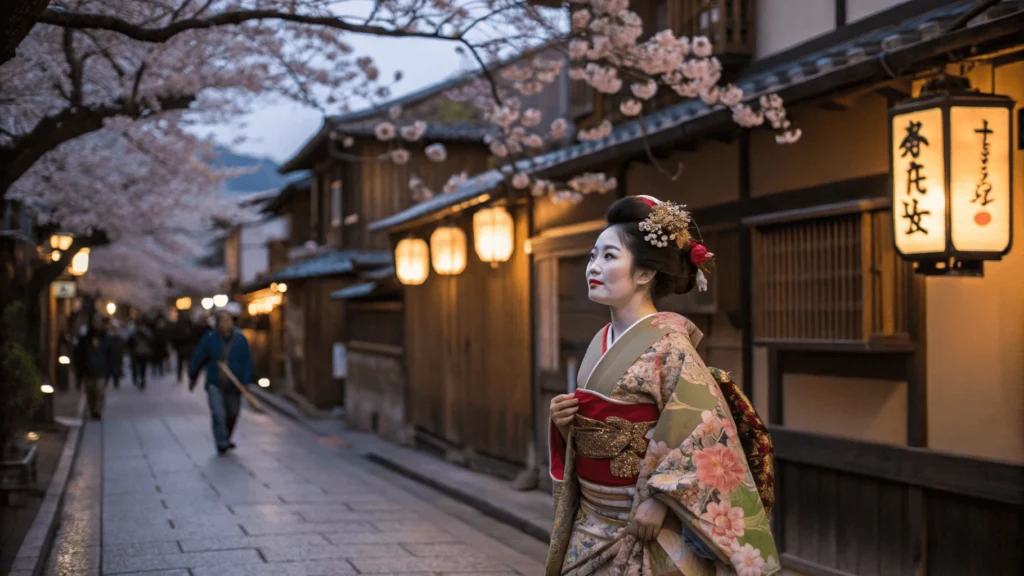
Often described as Japan’s most beautiful city, Kyoto served as the imperial capital for over 1,000 years, shaping Japanese arts, architecture, cuisine, and social customs. Unlike many Japanese cities, Kyoto was spared from bombing during World War II, preserving countless historical structures.
What Makes It Unique:
- Unparalleled concentration of temples, shrines, and traditional gardens
- Living traditions including geisha culture, tea ceremony, and traditional crafts
- Seasonal beauty, particularly cherry blossoms and autumn leaves
- Grid-pattern streets based on ancient Chinese urban planning
- Refined kaiseki cuisine and traditional confectionery
- Machiya traditional townhouses
Kyoto rewards slow travel, with many of its treasures hidden down side streets or requiring advance reservations. The city balances tourism with protecting its heritage, creating an atmosphere unlike anywhere else in Japan.
Osaka: The Vibrant Soul

If Tokyo represents Japan’s polished global face, Osaka reveals its beating heart. The city embraces a culture of straightforwardness, humor, commerce, and culinary obsession that distinguishes it from other Japanese urban centers.
What Makes It Unique:
- Food culture centered on street delicacies like takoyaki, okonomiyaki, and kushikatsu
- Distinctive Osaka dialect and comedy tradition
- Underground shopping complexes and covered shopping streets
- “Mizu no Miyako” (City of Water) with rivers and canals
- Distinct neighborhood personalities from upscale Umeda to gritty Shinsekai
- Castle town history alongside futuristic architecture
Osaka offers visitors an immersive urban experience that’s more accessible and unpretentious than many other Japanese cities, making it an excellent introduction to urban Japan.
Kobe: Elegant International Port
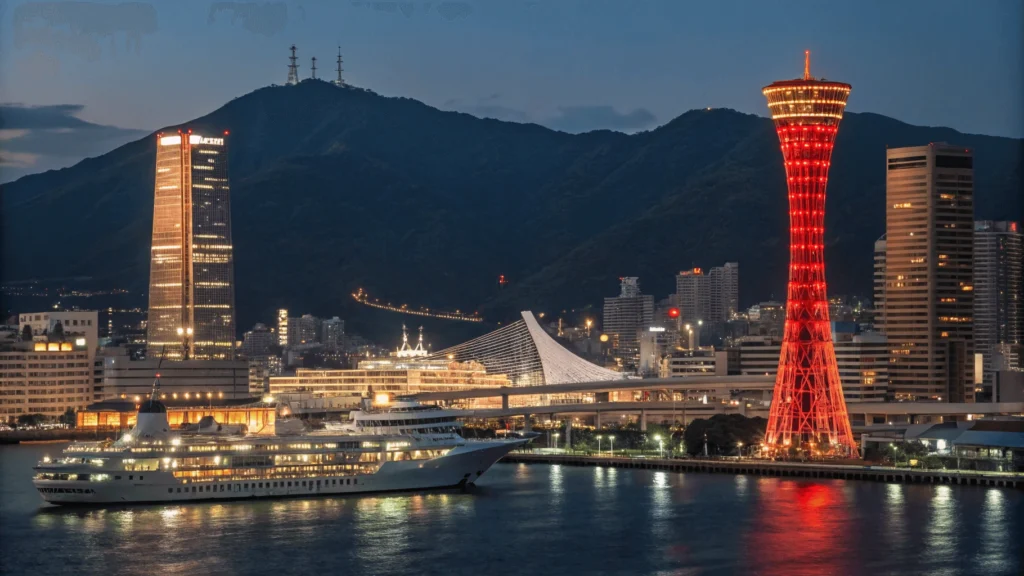
Nestled between mountains and sea, Kobe developed as one of Japan’s first international ports, creating a unique cosmopolitan atmosphere that blends global influences with Japanese refinement.
What Makes It Unique:
- Spectacular harbor views from Rokko Mountain
- International architecture in the Kitano district
- Sake brewing district of Nada
- World-famous Kobe beef
- Port Tower and harborfront developments
- Recovery story from the devastating 1995 earthquake
Kobe’s compact city center makes it easily explorable, while its sophisticated atmosphere offers a different perspective on urban Japan than its larger neighbors.
Nara: Living Museum City
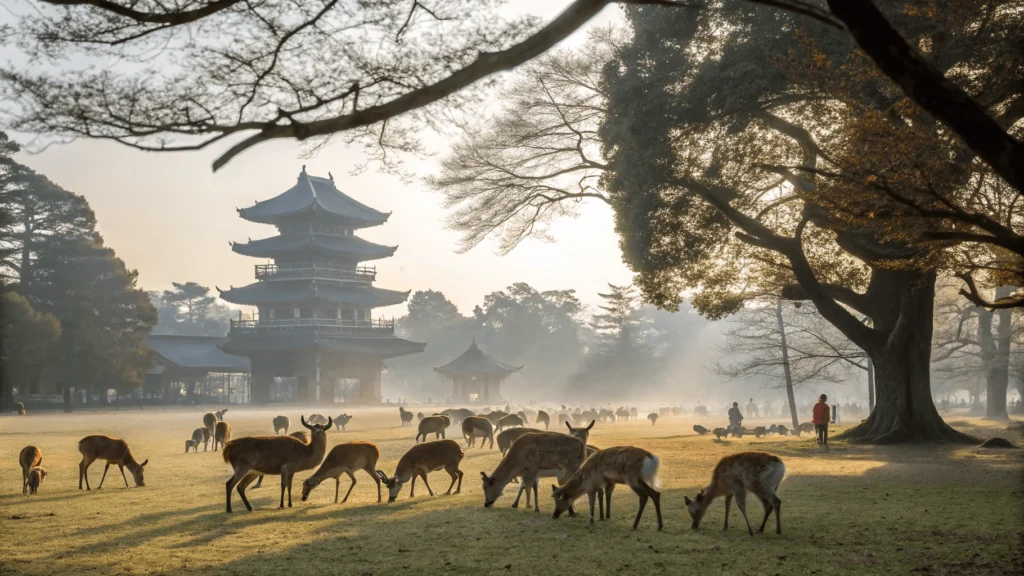
The compact city of Nara allows visitors to walk through Japanese history, with some of the nation’s oldest and most significant structures set amidst parkland where sacred deer roam freely.
What Makes It Unique:
- Walkable historical core centered around Nara Park
- Sacred deer considered messengers of the gods
- World’s largest bronze Buddha statue at Todai-ji
- Preserved atmosphere of ancient Japan
- Archaeological sites revealing Japan’s formative periods
- Naramachi traditional merchant district
Nara offers an accessible day trip from Kyoto or Osaka, though overnight stays reveal a more peaceful side of the city after day-trippers depart.
Key Attractions & Experiences in Kinki
History & Culture
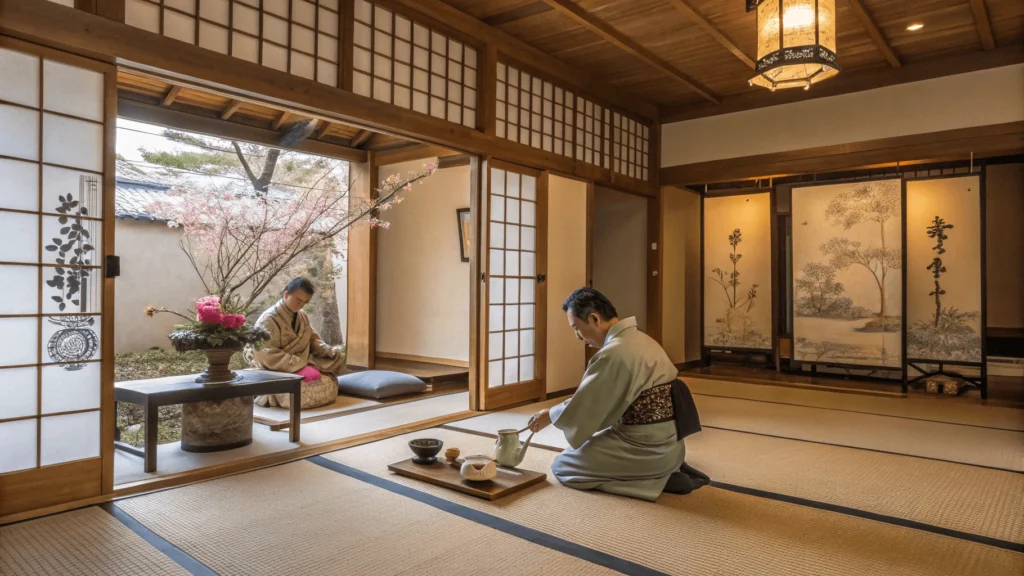
Imperial Heritage Sites
- Kyoto Imperial Palace: The former residence of Japan’s Imperial Family until 1868
- Heian Shrine: Recreating Kyoto’s imperial past with vermillion gates and gardens
- Nijo Castle: Shogun’s palace famous for “nightingale floors” that chirp when walked upon
- Horyu-ji Temple: Housing the world’s oldest wooden buildings dating to 607 CE
Living Cultural Traditions
- Gion Corner (Kyoto): Demonstrations of traditional arts like tea ceremony and ikebana
- Bunraku Theater (Osaka): Traditional puppet theater performances
- Miho Museum (Shiga): I.M. Pei-designed architectural masterpiece housing ancient art
- Traditional craft workshops: Hands-on experiences making Kiyomizu pottery, Nishijin textiles, or Japanese paper
Historical Architecture
- Himeji Castle: Japan’s most spectacular feudal castle and UNESCO site
- Byodo-in Phoenix Hall (Uji): The temple depicted on the 10-yen coin
- Tondaya (Kyoto): Historic merchant house with hidden rooms and gardens
- Imai-cho (Nara): Preserved Edo-period merchant town
Nature & Outdoors
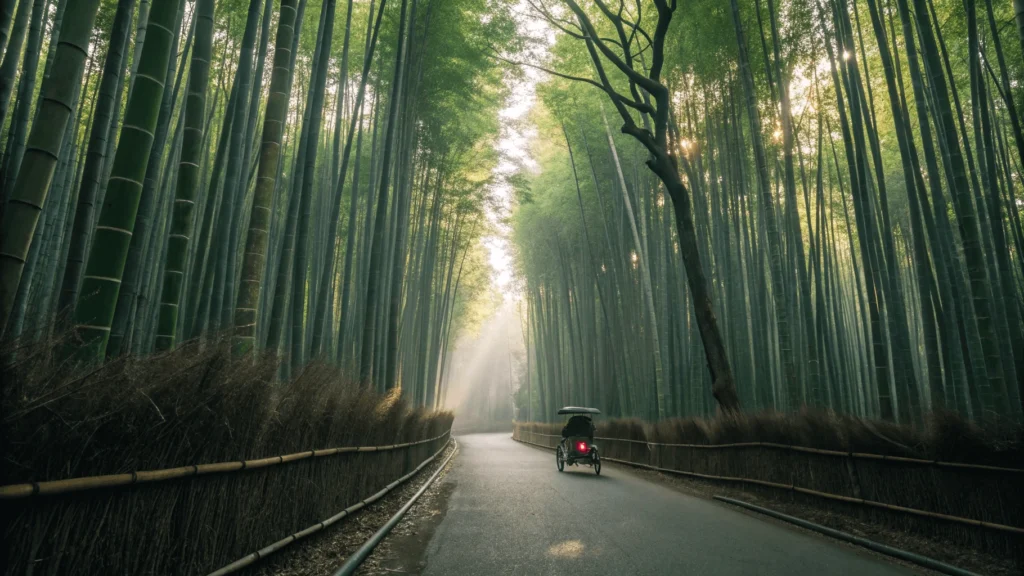
Mountain Landscapes
- Mount Koya: Sacred Buddhist mountain with over 100 temples
- Yoshino: Japan’s most famous cherry blossom viewing area
- Mount Rokko: Panoramic views of Kobe and Osaka Bay
- Kumano Mountains: Ancient pilgrimage routes through primeval forests
Water Features
- Lake Biwa: Japan’s largest freshwater lake with recreational activities
- Amanohashidate: “Bridge to Heaven” sand spit (one of Japan’s three scenic views)
- Nachi Falls: Japan’s tallest single-drop waterfall in a sacred setting
- Dorokyo Gorge: Dramatic river canyon with boat cruises
Gardens & Seasonal Beauty
- Adachi Museum Garden (border of Shimane): Consistently rated Japan’s best garden
- Arashiyama Bamboo Grove: Ethereal forest of towering bamboo
- Maruyama Park (Kyoto): Premier cherry blossom viewing location
- Minoo Park (Osaka): Accessible nature retreat famous for autumn colors
Food Experiences
Regional Specialties
- Kobe Beef: World-renowned marbled wagyu beef
- Kyoto Kaiseki: Multi-course traditional cuisine using seasonal ingredients
- Osaka Street Food Tour: Sampling takoyaki, okonomiyaki, kushikatsu and more
- Uji Matcha: Japan’s finest green tea and tea ceremony experiences
Culinary Activities
- Nishiki Market (Kyoto): “Kyoto’s Kitchen” food market exploration
- Sake Breweries: Tours in Nara’s Harushika or Kobe’s Nada district
- Cooking Classes: Learning to prepare regional specialties
- Depachika Food Halls: Basement food floors in department stores like Takashimaya
Dining Experiences
- Riverbed Dining (Kibune): Summer platforms over rushing mountain streams
- Izakaya Alleys: Tiny bar-restaurants in areas like Pontocho or Hozenji Yokocho
- Traditional Teahouses: Historic environments for tea and wagashi sweets
- Conveyor Belt Sushi: Modern casual dining originating in Osaka
Modern Attractions
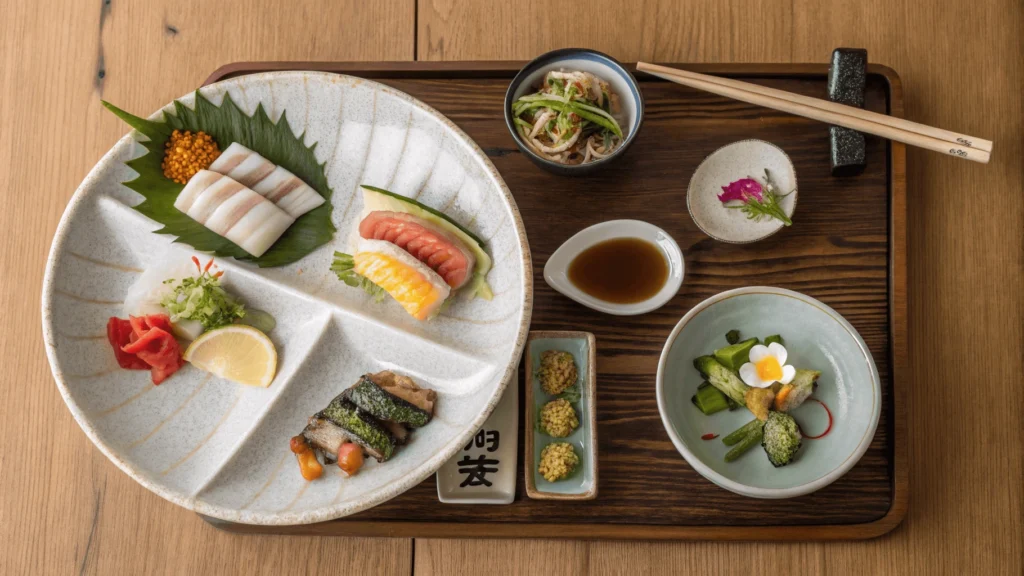
Urban Entertainment
- Universal Studios Japan (Osaka): Theme park with Super Nintendo World
- Osaka Aquarium Kaiyukan: One of the world’s largest aquariums
- Umeda Sky Building: Twin towers with floating garden observatory
- Kyoto Railway Museum: Comprehensive transportation museum
Contemporary Arts
- National Museum of Art, Osaka: Underground contemporary art museum
- Nakanoshima Museum of Art: New waterfront modern art destination
- Asahi Beer Oyamazaki Villa Museum: Blend of modern art in historic setting
- Tokujin Yoshioka designed spaces: Contemporary Japanese aesthetics
Shopping Districts
- Shinsaibashi & Dotonbori (Osaka): Vibrant shopping and entertainment
- Kawaramachi & Teramachi (Kyoto): Shopping arcades and department stores
- Sannomiya (Kobe): Fashion-forward shopping district
- Rinku Premium Outlets: Designer brand shopping near Kansai Airport
Spiritual Sites
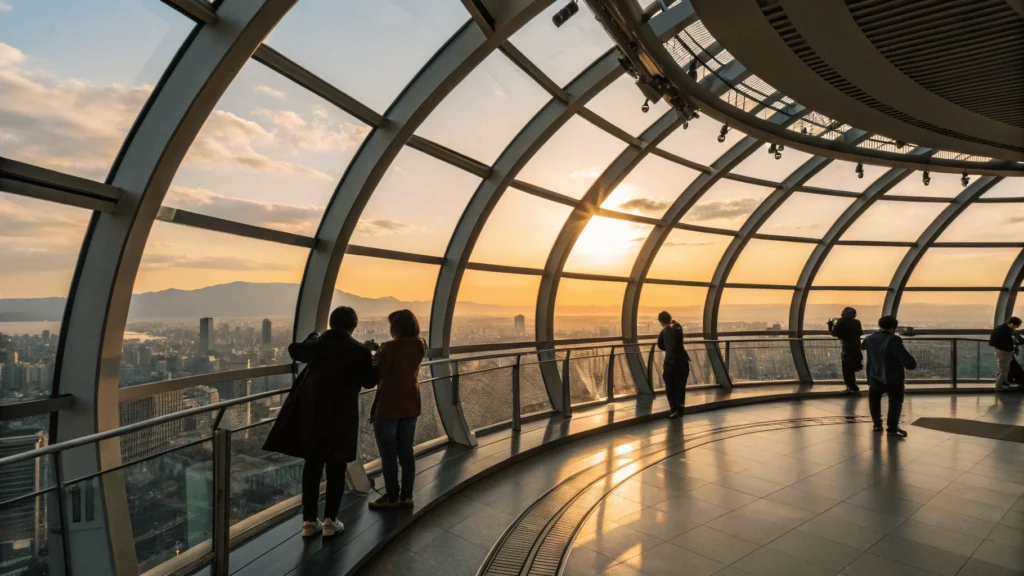
Buddhist Temples
- Todai-ji (Nara): Housing the Great Buddha in the world’s largest wooden building
- Kiyomizu-dera (Kyoto): Dramatic hillside temple with wooden stage
- Enryaku-ji (Mount Hiei): Headquarters of the Tendai Buddhist sect
- Kongōbu-ji (Mount Koya): Head temple of Shingon Buddhism
Shinto Shrines
- Fushimi Inari Taisha (Kyoto): Thousands of vermillion torii gates
- Ise Jingu (Mie): Japan’s most sacred Shinto shrine
- Kumano Sanzan (Wakayama): Three grand shrines on ancient pilgrimage routes
- Sumiyoshi Taisha (Osaka): One of Japan’s oldest Shinto shrines
Spiritual Experiences
- Shukubo Temple Stays: Overnight experiences in Buddhist temples
- Zazen Meditation: Guided sessions at Zen temples
- O-henro Pilgrimage: Walking sections of sacred pilgrimage paths
- Goma Fire Rituals: Witnessing esoteric Buddhist ceremonies
Transportation Guide: Navigating Kinki

Getting to Kinki
By Air Kansai International Airport (KIX) serves as the main gateway to the region, handling most international flights. Built on an artificial island in Osaka Bay, it connects to the mainland via bridge and express trains.
By Train The Shinkansen (bullet train) high-speed rail network connects the Kinki region to other parts of Japan:
- Tokyo to Kyoto: Approximately 2 hours 15 minutes
- Tokyo to Shin-Osaka: Approximately 2 hours 30 minutes
- Hiroshima to Shin-Osaka: Approximately 1 hour 30 minutes
By Bus Overnight highway buses offer economical transportation options from Tokyo and other major cities to Osaka, Kyoto, and Kobe.
Getting Around Kinki
JR Pass Considerations The Japan Rail Pass can provide excellent value for travelers exploring multiple regions of Japan, but those focusing solely on Kinki might consider these regional alternatives:
| Pass Name | Coverage Area | Duration Options | Best For |
|---|---|---|---|
| Kansai Area Pass | JR lines in Kinki + airport express | 1-4 days | Short stays with airport transfers |
| Kansai-Hiroshima Area Pass | Kinki + Hiroshima region | 5 days | Extended trips west |
| Kansai WIDE Area Pass | Kinki + Okayama, Kurashiki, Kinosaki | 5 days | Exploring beyond core cities |
Regional Transportation Networks The Kinki region benefits from dense, efficient public transportation:
- JR West: Extensive rail network connecting major cities and rural areas
- Private Railways: Companies like Hankyu, Keihan, Kintetsu, and Nankai offer alternative routes, often with direct access to tourist sites
- Subway Systems: Underground networks in Osaka, Kyoto, and Kobe
- Bus Networks: Comprehensive coverage including areas not served by rail
Transportation Tips
- Consider the ICOCA rechargeable IC card for seamless travel across multiple transit systems
- Major cities offer 1-day or 2-day tourist passes for unlimited transportation
- The Haruka Express provides the fastest connection between Kansai Airport and Kyoto
- Rural areas may have limited public transportation, with some buses running only a few times daily
Driving Considerations Renting a car makes sense primarily for exploring rural areas of Wakayama, Mie, and northern Kyoto Prefecture. Urban driving is challenging due to congestion, limited parking, and navigation difficulties. International Driving Permits are required for foreign visitors who wish to drive.
Best Time to Visit Kinki

Seasonal Highlights
Spring (March-May) The most popular season for visitors due to cherry blossoms (sakura) and pleasant temperatures. Key cherry blossom viewing spots include:
- Maruyama Park and Philosopher’s Path in Kyoto (late March to early April)
- Osaka Castle Park (early April)
- Yoshino in Nara Prefecture (mid to late April)
- Himeji Castle (early April)
Spring also features fresh green foliage and fewer crowds after cherry blossom season ends.
Summer (June-August) Hot and humid conditions with temperatures often exceeding 35°C (95°F). The season offers:
- Major festivals including Gion Matsuri in Kyoto (July)
- Tenjin Matsuri in Osaka (July)
- River dining platforms in Kibune and Takao
- Fireworks displays throughout the region
- Mount Koya and higher elevations provide relief from summer heat
Autumn (September-November) The second most popular season featuring spectacular fall foliage, comfortable temperatures, and harvest festivals. Prime autumn viewing spots include:
- Tofuku-ji and Eikan-do temples in Kyoto (November)
- Minoo Park near Osaka (mid to late November)
- Mount Rokko in Kobe (early November)
- Koyasan’s temple complexes (early November)
Winter (December-February) The quietest tourist season with cold but rarely severe weather (except in mountainous areas). Winter highlights include:
- Illumination events at temples and gardens
- Snow-covered temples in northern Kyoto and Mount Koya
- Hot spring resorts in Kinosaki and Arima
- Winter comfort foods like nabe (hot pot) and oden
- Significantly fewer crowds at major attractions
Major Festivals and Events
| Season | Event | Location | Description |
|---|---|---|---|
| January | Toka Ebisu | Nishinomiya Shrine, Hyogo | Business prosperity festival |
| February | Setsubun | Region-wide | Bean-throwing ceremony to drive away evil spirits |
| March | Omizutori | Todai-ji, Nara | Ancient water-drawing ceremony with flaming torches |
| April | Miyako Odori | Gion, Kyoto | Geisha dance performances |
| May | Aoi Matsuri | Kyoto | Ancient imperial procession |
| July | Gion Matsuri | Kyoto | Month-long festival with massive floats |
| July | Tenjin Matsuri | Osaka | One of Japan’s largest festivals with boat processions |
| August | Daimonji Gozan Okuribi | Kyoto | Mountain bonfires forming giant characters |
| October | Jidai Matsuri | Kyoto | Historical costume parade |
| November | Arashiyama Momiji Festival | Kyoto | Autumn leaf viewing with illuminations |
| December | Kasuga Wakamiya On-matsuri | Nara | Ancient court music and dance |
Weather Considerations
The Kinki region experiences four distinct seasons with varying conditions:
- Average Temperature Range: 5°C (41°F) in winter to 35°C (95°F) in summer
- Rainy Season: Typically early June to mid-July
- Typhoon Season: August to October, occasionally causing transportation disruptions
- Snowfall: Rare in coastal cities but common in northern Kyoto Prefecture and mountainous areas
Planning Your Trip to Kinki
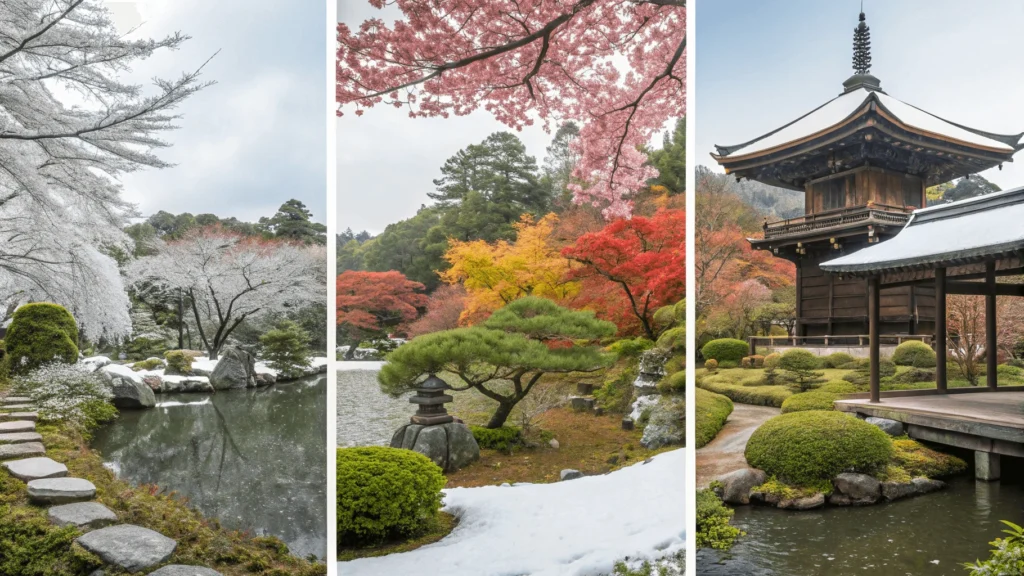
Sample Itineraries
7-Day Kinki Highlights
Day 1-3: Kyoto
- Focus on different districts each day (Eastern Kyoto temples, Downtown, Arashiyama)
- Mix of famous sites and hidden gems
- Evening experiences like geisha district walks or riverside dining
Day 4: Nara Day Trip
- Todai-ji Temple and Great Buddha
- Sacred deer in Nara Park
- Kasuga Taisha Shrine
- Return to Kyoto or continue to Osaka
Day 5-6: Osaka
- Osaka Castle and surroundings
- Dotonbori and food experiences
- Shopping districts and modern architecture
- Day trip option to Kobe or Himeji
Day 7: Mount Koya or Uji
- Sacred mountain temple complex or tea culture immersion
- Return to Osaka for departure or continue journey
10-Day Comprehensive Exploration
Day 1-3: Kyoto
- Similar to 7-day itinerary but with more depth
Day 4: Uji and Southern Kyoto
- Byodo-in Temple
- Matcha experiences
- Fushimi Inari evening visit
Day 5: Nara
- Full day exploring ancient capital
Day 6-7: Osaka
- City exploration with more neighborhood variety
- Day trip to Himeji Castle
Day 8: Kobe
- Harbor district
- Sake breweries
- Mount Rokko for night views
Day 9-10: Mount Koya
- Overnight temple stay
- Cemetery exploration
- Buddhist ceremonies
Budget Considerations
Accommodation
- Budget: Hostels, capsule hotels, and business hotels from ¥3,000-6,000 per night
- Mid-range: Modern hotels and ryokan from ¥8,000-15,000 per night
- Luxury: High-end ryokan and international hotels from ¥20,000+ per night
Food
- Budget: Convenience stores, standing sushi, and street food from ¥500-1,000 per meal
- Mid-range: Family restaurants and casual izakaya from ¥1,500-3,000 per meal
- Luxury: Kaiseki cuisine and premium restaurants from ¥10,000+ per meal
Transportation
- 7-day JR Kansai Wide Area Pass: Approximately ¥10,000
- City subway day passes: ¥600-900
- Airport transfers: ¥1,000-3,000
Attraction Admission
- Temples and shrines: ¥300-1,500 per site
- Museums: ¥500-2,000
- Theme parks: ¥7,000-8,000
Total Daily Budget
- Budget traveler: ¥8,000-12,000 per day
- Mid-range traveler: ¥15,000-25,000 per day
- Luxury traveler: ¥30,000+ per day
Accommodation Types
Traditional Options
- Ryokan: Traditional inns offering tatami rooms, futon bedding, and often kaiseki meals and onsen baths
- Shukubo: Temple lodgings offering simple accommodations and opportunities to participate in Buddhist practices
- Minshuku: Family-run guesthouses, like B&Bs with Japanese characteristics
Modern Options
- Business Hotels: Compact, efficient accommodations catering to domestic travelers
- International Hotel Chains: Western-style comforts with Japanese hospitality touches
- Boutique Hotels: Often blending traditional Japanese aesthetics with modern amenities
Alternative Options
- Machiya Stays: Renovated traditional townhouses offering self-catering accommodations
- Capsule Hotels: Ultra-compact accommodations popular for short stays
- Guesthouse/Hostels: Social accommodations popular with international travelers
Why Visit Kinki?: The Region’s Unique Appeal
The Kinki region offers travelers a remarkably comprehensive Japanese experience within a manageable geographical area. Its unique selling points include:
Cultural Depth
As the cradle of Japanese civilization, Kinki presents an unparalleled concentration of historical and cultural treasures. The region houses over 60% of Japan’s National Treasures, allowing visitors to experience the evolution of Japanese aesthetics, architecture, and arts across more than a millennium.
Geographical Diversity
Within a relatively compact area, travelers can experience:
- Vibrant urban centers
- Ancient religious complexes
- Rural farming villages
- Coastal fishing communities
- Mountain retreats
- Lake environments
- Hot spring resorts
This diversity allows for efficient exploration of Japan’s varied landscapes without extensive travel.
Culinary Excellence
The region pioneered many Japanese culinary traditions:
- Kyoto’s refined kaiseki cuisine developed to serve imperial courts
- Osaka’s street food culture reflecting its merchant history
- Kobe’s international influences creating fusion traditions
- Traditional tea culture centered in Uji
- Sake brewing excellence in Nara and Kobe
Accessibility
The region’s excellent transportation infrastructure makes exploration straightforward:
- Compact urban centers easily navigated by public transportation
- Major attractions connected by efficient rail networks
- International gateway via Kansai Airport
- English signage in tourist areas
Living Traditions
Unlike some historical destinations where traditional practices exist primarily for tourism, Kinki’s cultural traditions remain vibrant parts of daily life:
- Active geisha communities in Kyoto’s Gion and Pontocho
- Continuing production of traditional crafts using centuries-old techniques
- Religious practices maintained at thousands of active temples and shrines
- Traditional performing arts regularly presented
Perfect Introduction to Japan
For first-time visitors to Japan, Kinki offers the perfect introduction:
- More manageable urban scale than Tokyo
- More concentrated historical sites than any other region
- Distinctive regional character and dialects
- Blend of modern conveniences with traditional aesthetics
FAQs About Kinki Japan
Q: What prefectures are included in the Kinki region?
The Kinki region officially includes seven prefectures: Osaka, Kyoto, Hyogo, Nara, Shiga, Wakayama, and Mie. Some definitions may include slightly different boundaries.
Q: Is Kyoto in Kinki?
Yes, Kyoto Prefecture is one of the core prefectures in the Kinki region, containing the former imperial capital city of Kyoto.
Q: What’s the difference between Kinki and Kansai?
“Kinki” is the official geographic designation, while “Kansai” is the more commonly used colloquial term for essentially the same region. “Kinki” means “near the capital,” while “Kansai” means “west of the barrier,” referring to its location west of the historical checkpoint that separated eastern and western Japan.
Q: When is the best time to visit the Kinki region?
The most popular times to visit are spring (March-April) for cherry blossoms and autumn (October-November) for fall foliage. However, each season offers unique attractions. Winter has fewer tourists but can be cold, while summer features exciting festivals despite hot and humid conditions.
Q: How many days should I spend in the Kinki region?
Ideally, allow at least 7-10 days to explore the major highlights of Kyoto, Osaka, Nara, and one or two additional areas. With two weeks, you can have a more comprehensive experience including mountain stays and coastal areas.
Q: Is English widely spoken in the Kinki region?
English signage is common at major tourist sites and transportation hubs. However, English speakers are not as prevalent as in Tokyo, especially in smaller cities and rural areas. Basic Japanese phrases and a translation app are helpful for smoother communication.
Q: Is the Japan Rail Pass worth it for exploring the Kinki region?
If you’re only exploring the Kinki region, regional passes like the JR Kansai Wide Area Pass often provide better value. The nationwide JR Pass is more economical if you’re also traveling to/from Tokyo or other distant regions.
Q: What’s the difference between Osaka and Kyoto?
Though just 30 minutes apart by train, these cities offer contrasting experiences. Kyoto emphasizes traditional culture, temples, and refined aesthetics, while Osaka is known for its modern urban energy, food culture, and outgoing personality.
Q: Is Kinki safe for tourists?
The Kinki region, like most of Japan, has very low crime rates and is generally extremely safe for tourists. The main concerns are natural disasters like earthquakes and typhoons, which Japan is well-prepared to handle.
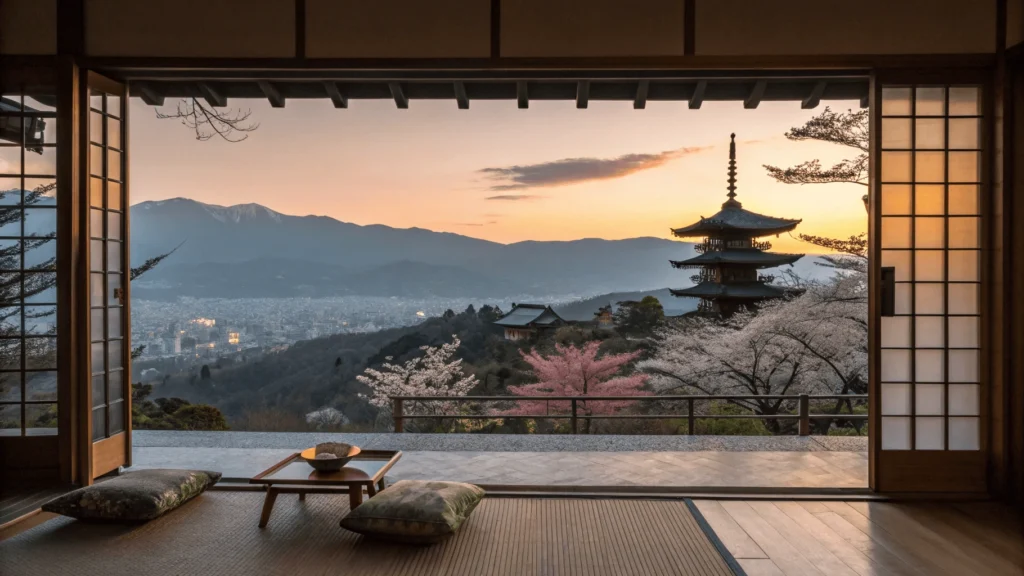
Conclusion: Embracing the Soul of Japan
The Kinki region represents the cultural bedrock of Japanese civilization, where ancient traditions seamlessly blend with modern innovation. Its landscapes tell the story of Japan’s development from imperial beginnings through feudal periods to contemporary prosperity. Whether you’re drawn to architectural masterpieces, spiritual experiences, culinary adventures, or natural beauty, Kinki offers rich rewards for curious travelers.
What makes Kinki truly special is not just its collection of world-class attractions but how these elements come together to create a multi-layered experience that engages all the senses. The scent of incense in ancient temples, the taste of perfectly crafted kaiseki cuisine, the sound of shrine bells echoing through forested mountains, the sight of illuminated gardens reflecting in still ponds—these sensory experiences create memories that last far beyond photographs or souvenirs.
As you plan your journey to the Kinki region, remember that its greatest treasures often reveal themselves to those who take time to explore beyond the obvious highlights. Allow yourself to wander down quiet backstreets, engage with local artisans, participate in seasonal festivals, and embrace the distinctive regional character that makes this area the beating heart of traditional Japan.
Whether you’re making your first trip to Japan or returning to explore more deeply, the Kinki region offers an unparalleled window into the soul of this fascinating country—a place where every visitor can discover their own personal connection to Japan’s enduring cultural legacy.

